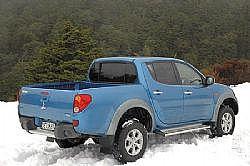The new and very different looking Triton has arrived. As we went to press we had yet to drive it but secured the official launch information. Like many we had seen early examples of Triton on display at Fieldays so had already seen the quite rounded frontal treatment, not dissimilar to the Dakar Rally Pajeros.
The curved styling, including door and window lines, gives Triton a powerfully striking visual presence that makes it stand out from the rest. These lines also give Triton an aerodynamic shape that reduces wind resistance, and apparently vibration and noise.
The large wheel arches, over 16-inch rims, give Triton a very business-like, appearance, and signal its intent to go off-road.
Mitsubishi claim excellent approach and departure angles and Tritons ability to handle serious terrain. All well-side models come with a front skid plate for extra protection, a rear step plate, and the GLS, sports model adds an aluminium side step for convenience.
Hooks are built into the inside of the deck to add convenience for securing loads without disturbing airflow.
Triton has a roomy and quite stylish cabin, with high-quality fittings; a far more modern and comfortable interior than its predecessor. It is said to be very quiet, in part due to vortex generators on the wing mirrors that further reduce wind noise and resistance.
Seat coverings are modern and hard-wearing, and the double cab models feature adjustable sports seats up front. The seats themselves are designed for comfort and support, with ample legroom for front and rear occupants.
The sweeping dashboard features striking, blue-lit, circular meters as well as CD/MP3 player, which feeds 2, 4 or 6 speakers depending on model. Air conditioning is standard across the range but the GLS gets climate control and a Multi Function Display (MFD).
MFD shows information like fuel consumption, temperature, compass bearing, air pressure and altitude as well as CD/MP3 and heater/air conditioner settings.
The GLS adds a leather-bound gear stick, map lamps, a sunglasses holder, and a rear seat armrest with cup holders and a silver trim finish. Power windows are standard throughout the range, and the GLS adds a heated power window in the rear windscreen to enable access to the tray.
The GLS Sport is further distinguished by body-coloured bumpers, metallic grey wheel arch extensions, driving lamps and alloy rims, with 245/70R16 tyres.
The new Triton range offers two new engine options both inherited from Pajero: The 3.2-litre, common-rail, inter-cooled, turbo-diesel (CDi), which has 28 percent more power, 120kW at 3,800rpm, and 19 percent more torque, 353Nm at 2,000rpm.
And the 3.5-litre, petrol V6, which produces 137kW at 5,000rpm and 314Nm at 3,500rpm.
Despite the power improvements, both power plants still claim competitive fuel economy; 13L/100km for the V6 and 9.1L/100km for the diesel, an improvement of 11 percent over its predecessor.
The diesel power plant is coupled with a 5-speed manual transmission, while the petrol has either a manual transmission or an automatic option, for the GLS specification only. All models have Easy Select 4WD allowing the driver to engage 4WD at speeds up to 100km/h. Triton is also equipped with a rear diff lock, the only vehicle in its class to do so, further reinforcing its off-road claim.
Both GLS and GLX specifications have the same double wishbone, coil sprung front suspension but two levels of rear elliptic leaf suspension; the GLX, workhorse, models have a heavy duty version.
Triton uses a power-assisted rack and pinion steering system that gives it a class-leading turning circle of 11.8 metres.
Mitsubishis RISE body construction, which controls how the body reacts to impacts, uses crumple zones in the front and rear to absorb impact energy, while reinforced beams redirect it away from the occupants, keeping them safely surrounded in a rigid, high-tensile frame.
The body sits on top of a wider and stronger ladder frame that also controls how impacts are absorbed, and side impact bars give the occupants protection from side-on collisions. The frame offers excellent torsional rigidity in 4WD situations where one or more wheels loose contact with the ground.
Driver and passenger airbags are standard across the range, as are the collapsible steering column and anti-intrusion brake pedal. The passenger airbag can be manually switched off, when a child seat is installed. Child restraint tether anchors are included in both GLS and GLX specifications.
Keyless entry and central locking, plus the engine immobiliser, give Triton security and convenience. The double cab includes childproof locks on the rear doors.
The prices are competitive, especially at the top of the range. The GLX single cab chassis 3.5 V6 and 3.2 CDi both start at $38,990, while the GLS double cab 3.5 V6 auto tops out at $48,990, well below many competitors..:




